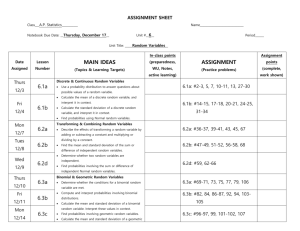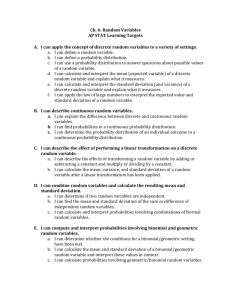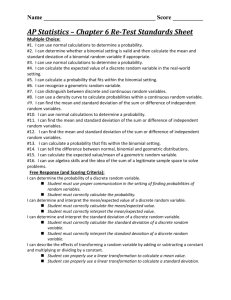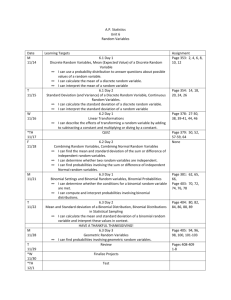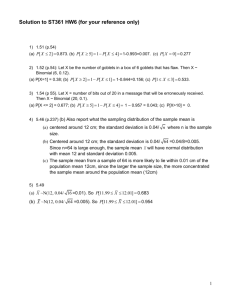AP Statistics: Probability & Random Variables Review
advertisement
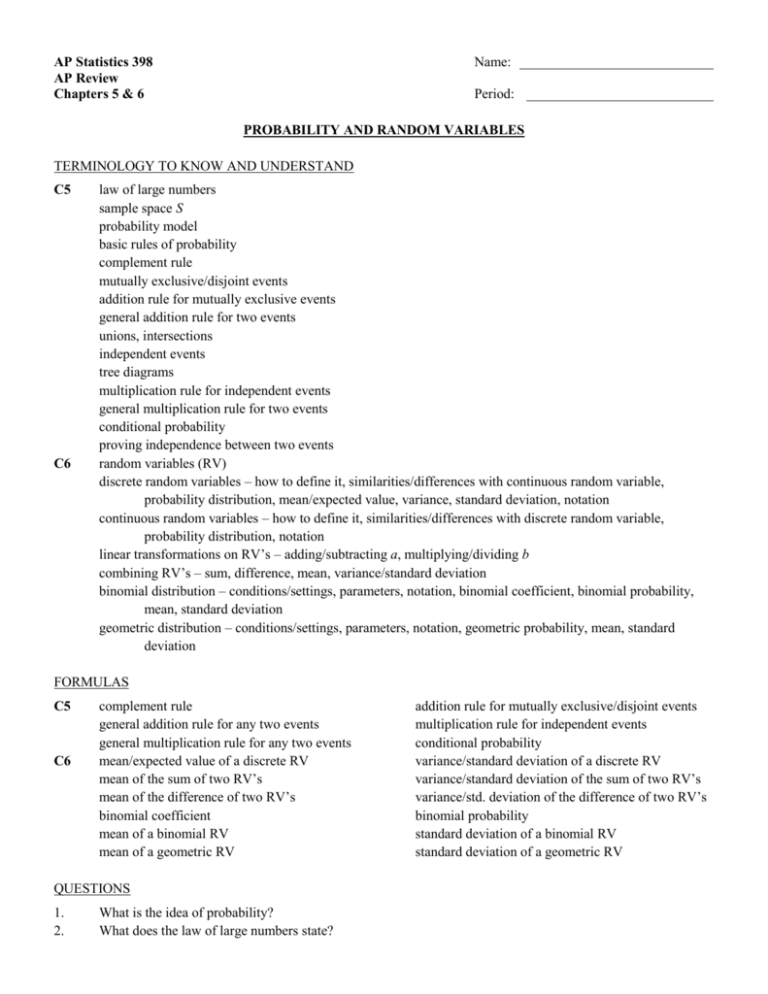
AP Statistics 398 AP Review Chapters 5 & 6 Name: ____________________________ Period: ___________________________ PROBABILITY AND RANDOM VARIABLES TERMINOLOGY TO KNOW AND UNDERSTAND C5 C6 law of large numbers sample space S probability model basic rules of probability complement rule mutually exclusive/disjoint events addition rule for mutually exclusive events general addition rule for two events unions, intersections independent events tree diagrams multiplication rule for independent events general multiplication rule for two events conditional probability proving independence between two events random variables (RV) discrete random variables – how to define it, similarities/differences with continuous random variable, probability distribution, mean/expected value, variance, standard deviation, notation continuous random variables – how to define it, similarities/differences with discrete random variable, probability distribution, notation linear transformations on RV’s – adding/subtracting a, multiplying/dividing b combining RV’s – sum, difference, mean, variance/standard deviation binomial distribution – conditions/settings, parameters, notation, binomial coefficient, binomial probability, mean, standard deviation geometric distribution – conditions/settings, parameters, notation, geometric probability, mean, standard deviation FORMULAS C5 C6 complement rule general addition rule for any two events general multiplication rule for any two events mean/expected value of a discrete RV mean of the sum of two RV’s mean of the difference of two RV’s binomial coefficient mean of a binomial RV mean of a geometric RV QUESTIONS 1. 2. What is the idea of probability? What does the law of large numbers state? addition rule for mutually exclusive/disjoint events multiplication rule for independent events conditional probability variance/standard deviation of a discrete RV variance/standard deviation of the sum of two RV’s variance/std. deviation of the difference of two RV’s binomial probability standard deviation of a binomial RV standard deviation of a geometric RV 3. 4. 5. 6. 27. 28. 29. 30. 31. 32. What are the components to a probability model/probability distribution? What are the basic rules of probability, including the complement rule? What can be stated about two events that are mutually exclusive/disjoint? What probability rule can be used? State the addition rule for mutually exclusive/disjoint events. State the general addition rule for any two events. How can Venn diagrams be used to help solve probability problems? What notation is used? What can be stated about two events that are independent? What probability rule can be used? What is conditional probability? What notation is used? How can tree diagrams be used to help solve probability problems? State the multiplication rule for independent events. State the general multiplication rule for any two events. The addition rule holds if and only if two events are -?-, and the multiplication rule holds if and only if two events are -?-. -?- events can never be -?-. What are two approaches to proving independence between two events? What is a random variable X? How is the probability model/probability distribution of a discrete random variable described? When calculating the expected value/mean of a discrete random variable, should the final answer be rounded to an integer? How can the TI graphing calculator help to quickly calculate the expected value/mean and standard deviation of a discrete random variable? How is the probability model/probability distribution of a continuous random variable described? What are the differences between a discrete random variable and a continuous random variable? How do the probability models/probability distributions differ between a discrete random variable and a continuous random variable? Does the probability to an individual outcome exist if the random variable is discrete? What if the random variable is continuous? Does the linear transformation of adding a affect the mean of a random variable? How? Does it affect the variance? How? Does it affect the standard deviation? How? Does the linear transformation of multiplying by b affect the mean of a random variable? How? Does it affect the variance? How? Does it affect the standard deviation? How? -?- of two independent random variables add, -?- do not. When combining two random variables with linear transformations, which is performed first: the linear transformation or the combination? What are the conditions/settings for all binomial random variables? What does the binomial random variable X count? What is the standard notation used to signify a binomial distribution? When is BINOMPDF used? BINOMCDF? If using calculator syntax, what else must always be included? If X were a binomial random variable, how do you find P X n ? P X n ? 33. 34. 35. 36. 37. What are the formulas for the mean and standard deviation of a binomial random variable? What are the conditions/settings for all geometric random variables? What does the geometric random variable X count? When is GEOMETPDF used? GEOMETCDF? If X were a geometric random variable, how do you find P X n ? P X n ? 38. What are the formula for the mean and standard deviation (not on the equation sheet) of a geometric random variable? 7. 8. 9. 10. 11. 12. 13. 14. 15. 16. 17. 18. 19. 20. 21. 22. 23. 24. 25. 26. PRACTICE MULTIPLE CHOICE PROBLEMS Pages 461 – 464 Pages 667 – 670 Pages 799 – 805 # 2, 4, 9, 18, 19, 20 # 1, 2, 7, 10, 14, 30 # 2, 8, 12, 16, 22, 32, 40 (Cumulative AP Practice Test 2) (Cumulative AP Practice Test 3) (Cumulative AP Practice Test 4) PRACTICE AP FREE RESPONSE 2011 #2 The table below shows the political party registration by gender of all 500 registered voters in Franklin Township. (a) Given that a randomly selected registered voter is a male, what is the probability that he is registered for Party Y? (b) Among the registered voters of Franklin Township, are the events “is a male” and “is registered for Party Y” independent? Justify your answer based on probabilities calculated from the table above. (c) One way to display the data in the table is to use a segmented bar graph. The following segmented bar graph, constructed from the data in the party registration – Franklin Township table, shows party-registration distributions for males and females in Franklin Township. In Lawrence Township, the proportions of all registered voters for Parties W, X, and Y are the same as for Franklin Township, and party registration is independent of gender. Complete the graph below to show the distributions of party registration by gender in Lawrence Township.
